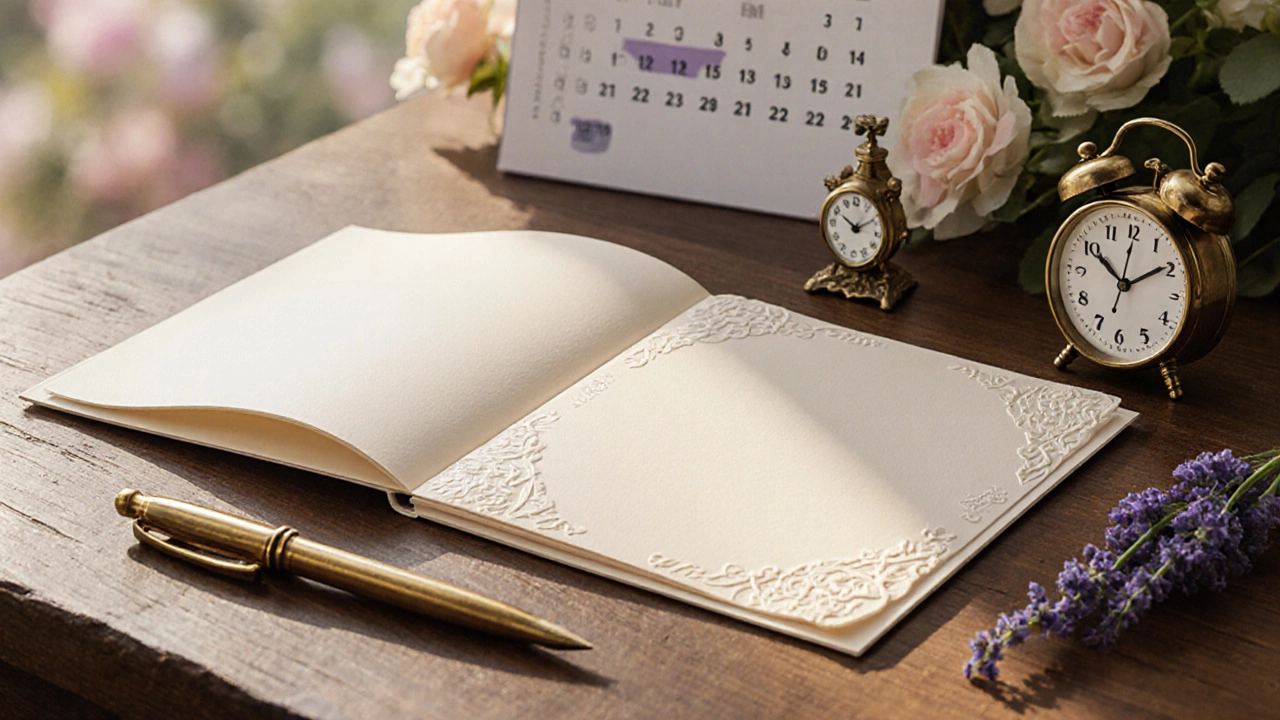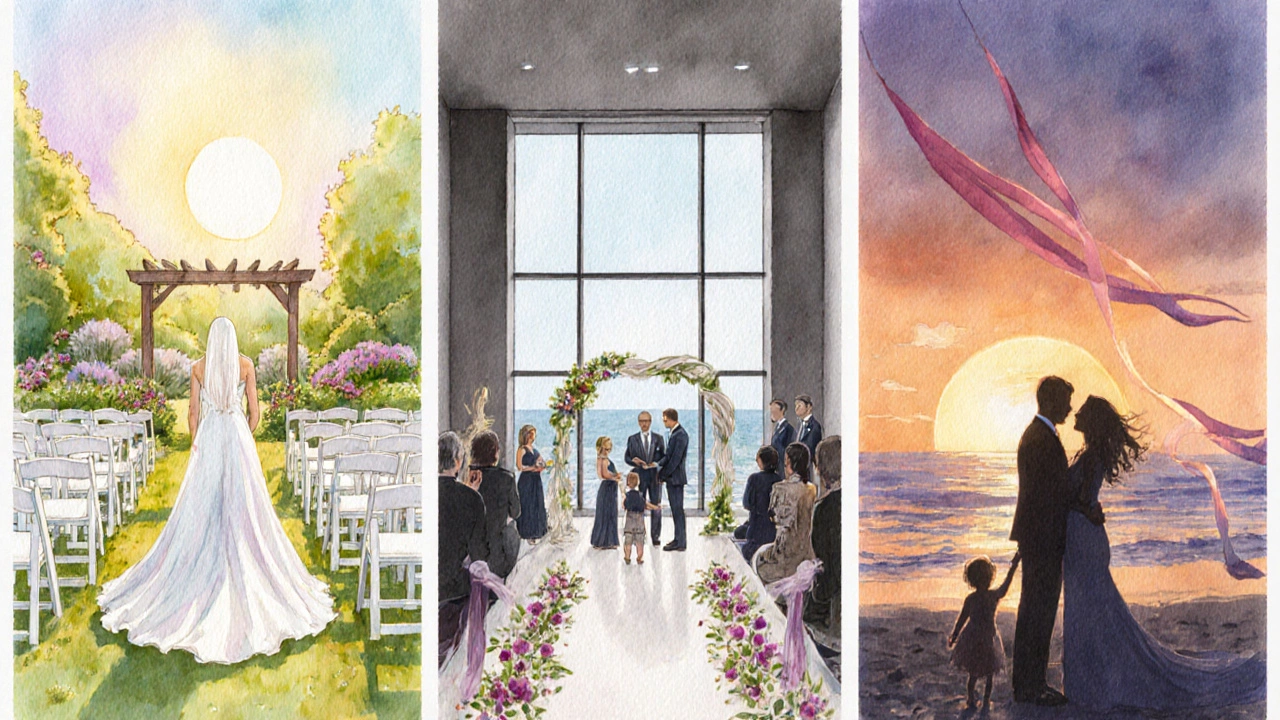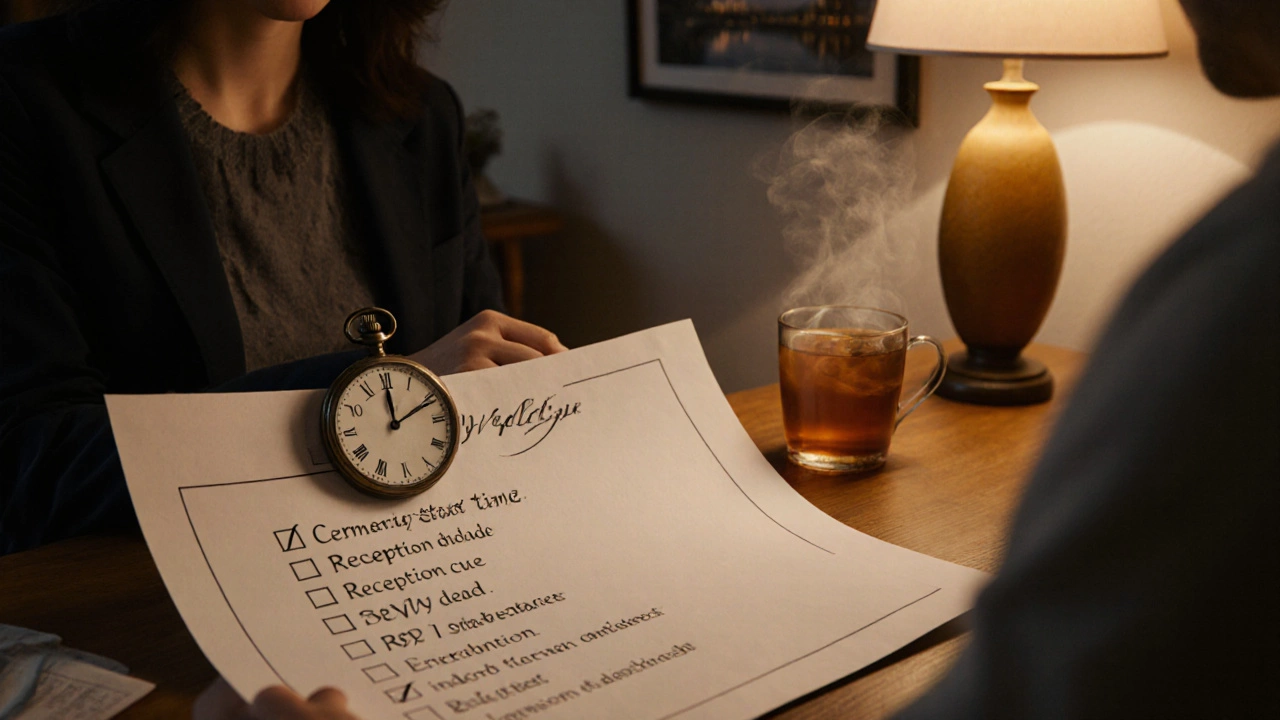Wedding Invitation Time: When to List the Ceremony Start
 Oct, 19 2025
Oct, 19 2025
Wedding Ceremony Time Calculator
Find the Perfect Ceremony Time
This tool helps you determine the ideal ceremony start time based on your wedding details and venue requirements.
Planning Tips
Important: Always confirm venue curfew and daylight conditions before finalizing your schedule.
When you’re piecing together a wedding invitation, the time you print for the ceremony is more than a simple detail - it sets the rhythm for the whole day. A wrong or vague hour can throw off guests’ travel plans, clash with daylight, or even cause confusion about when the reception kicks off. Below we break down exactly how to decide the perfect time to put on your invitation, why it matters, and what extra tweaks you might need for a smooth‑running wedding.
Why the Ceremony Time Is a Deal‑Breaker
Think about the last event you attended where the start time was unclear. Chances are you arrived early, waited in the lobby, or missed the opening altogether. The same anxiety shows up at weddings, especially when guests are traveling from out of town or juggling work schedules. The Wedding invitation is the official notice that tells guests when to be present, what attire to wear, and what vibe to expect serves as the first point of coordination between you and your guests.
Getting the time right also influences:
- Transportation logistics - trains, flights, taxis.
- Photographer’s schedule - golden hour light vs. harsh midday sun.
- Venue restrictions - some halls lock doors after a certain hour.
- Guest comfort - avoiding too‑early mornings or late‑night fatigue.
Common Mistakes Couples Make
Even seasoned planners slip up. Here are the pitfalls to watch out for:
- Leaving the time out entirely. Some couples assume the venue name is enough, but without a clock, guests are left guessing.
- Using vague ranges. “Afternoon ceremony” sounds casual but offers no concrete guidance for travel planning.
- Not accounting for daylight. A 5 pm ceremony in June may still be bright, while a 4 pm winter event could plunge into darkness.
- Clashing with other scheduled events. If you booked a venue that ends at 10 pm, a 9:30 pm ceremony leaves no room for the reception.
Choosing the Right Ceremony Start Time
The ideal hour depends on three main factors: your venue’s natural light, your guest profile, and the overall vibe you want. Below are three common windows and the scenarios they suit best.
Morning (9 am - 11 am)
This window works wonders for:
- Garden or beach weddings that want soft, natural light.
- Guests who prefer an early finish and a relaxed brunch afterward.
- Couples aiming for a classic, low‑key atmosphere.
Potential downside: early‑rising guests and limited public transport in some cities.
Afternoon (1 pm - 3 pm)
Mid‑day ceremonies strike a balance between daylight and guest convenience. They’re perfect for:
- Urban venues with indoor space that need natural light for photos.
- Families with children, as the timing avoids nap‑time conflicts.
- Events that plan a cocktail hour followed by an early dinner.
Keep an eye on the sun’s intensity - you may need shade or a cooling plan for hot climates.
Evening (5 pm - 7 pm)
Evening ceremonies are romantic, especially when the sun sets over the horizon. They suit:
- Destination weddings where guests fly in that afternoon.
- Couples who love a twilight backdrop for photos.
- Reception plans that blend into a night‑time dance floor.
Watch out for venue curfews and extra lighting costs.
Coordinating Reception Time
Once you’ve nailed the ceremony start, the next step is to line up the reception. A common rule of thumb is to schedule the reception to start about 45 minutes after the ceremony ends. This gives guests a breather, photographers time to capture the walk‑down, and the venue crew a chance to transition the space.
| Ceremony Window | Suggested Start Time | Estimated Length | Reception Start | Vibe |
|---|---|---|---|---|
| Morning | 9:30 am | 30 min | 10:30 am (brunch reception) | Fresh, airy |
| Afternoon | 2:00 pm | 45 min | 3:00 pm (cocktail hour) | Classic, relaxed |
| Evening | 5:30 pm | 45 min | 6:30 pm (dinner & dancing) | Romantic, festive |
Notice how each row pairs a start time with a realistic reception window. Adjust the “Estimated Length” based on any cultural rituals you include - a tea ceremony or a sand‑blending ritual could add 15‑20 minutes.
RSVP Deadline and Timeline
Guests need enough time to respond, and you need enough time to confirm numbers with the caterer. A solid rule is to set the RSVP deadline at least three weeks before the big day. Here’s a quick timeline:
- Save‑the‑Date sent: 9‑12 months ahead.
- Formal invitation mailed: 6‑8 weeks before wedding.
- RSVP deadline: 3 weeks before wedding.
- Final headcount to venue/caterer: 2 weeks before wedding.
Make sure the invitation clearly states the RSVP date, preferably in a bold line separate from other text, e.g., “Please RSVP by June 15 2026.”

Special Considerations
Every wedding has unique elements that can shift the optimal time. Below are the most common variables to keep in mind.
Cultural or Religious Traditions
Some traditions dictate specific times - for example, a Hindu sunrise ceremony or a Jewish “Shkiah” (sunset) wedding. In those cases, the Ceremony start time must align with religious calendar or auspicious hour rather than personal preference.
Time‑Zone Differences for Destination Weddings
If many guests are flying in from abroad, consider their jet‑lag. A 5 pm local start might feel like midnight for someone traveling from a far‑away country. Offering a welcome dinner the night before can smooth the transition.
Daylight Savings and Seasonal Light
In the Southern Hemisphere, October (when you’re writing this) brings longer daylight, making a 4 pm ceremony still quite bright. In contrast, a December wedding may need an earlier start or added lighting.
Venue Constraints
Historic churches often lock their doors at a set hour, while outdoor venues may have noise curfews. Always double‑check the venue’s official start‑end times before locking the invitation time.
Guest Travel and Parking
Think about when public transport runs and when parking is most available. A 9 am ceremony in a city center might clash with rush‑hour traffic, whereas a 2 pm event lets guests arrive after peak congestion.
Print‑Ready Checklist Before Sending Out Invites
Use this quick list to verify you haven’t missed a time‑related detail:
- ✔️ Ceremony start time printed clearly (e.g., “Saturday, 5 October 2026, 4:30 pm”).
- ✔️ Reception start time or cue (e.g., “Reception to follow at 5:30 pm”).
- ✔️ RSVP deadline bolded and separated from other text.
- ✔️ Any cultural time notes (e.g., “Sunrise ceremony - please arrive by 5:45 am”).
- ✔️ Venue address with clear directions and parking info.
- ✔️ Contact number for last‑minute changes.
- ✔️ Proofread for AM/PM consistency.
Once this checklist is green, you’re ready to print and mail.
When should I list the ceremony start time on my invitation?
Print the exact start time (hour and minutes) on the invitation itself, not just the date. Guests need that detail to plan travel, meals, and attire.
Is it okay to put the reception time on the same line as the ceremony?
Prefer a separate line or a different card. Mixing the two can cause confusion, especially if the reception starts an hour later.

How far in advance should I send my wedding invitations?
Send them 6‑8 weeks before the wedding. This gives guests enough time to book travel and RSVP by the three‑week deadline.
What if my venue has a curfew?
Plan the ceremony and reception so the last dance ends at least 30 minutes before the curfew. Adjust the start time accordingly.
Do I need to mention daylight‑saving time changes?
If your wedding falls near a DST shift, note the local time zone (e.g., “4:30 pm AEDT”). That removes ambiguity for out‑of‑town guests.
Can I use a vague time like ‘late afternoon’?
Avoid it. “Late afternoon” could mean 3 pm to 6 pm, which is too wide for travel planning. Choose a specific hour.